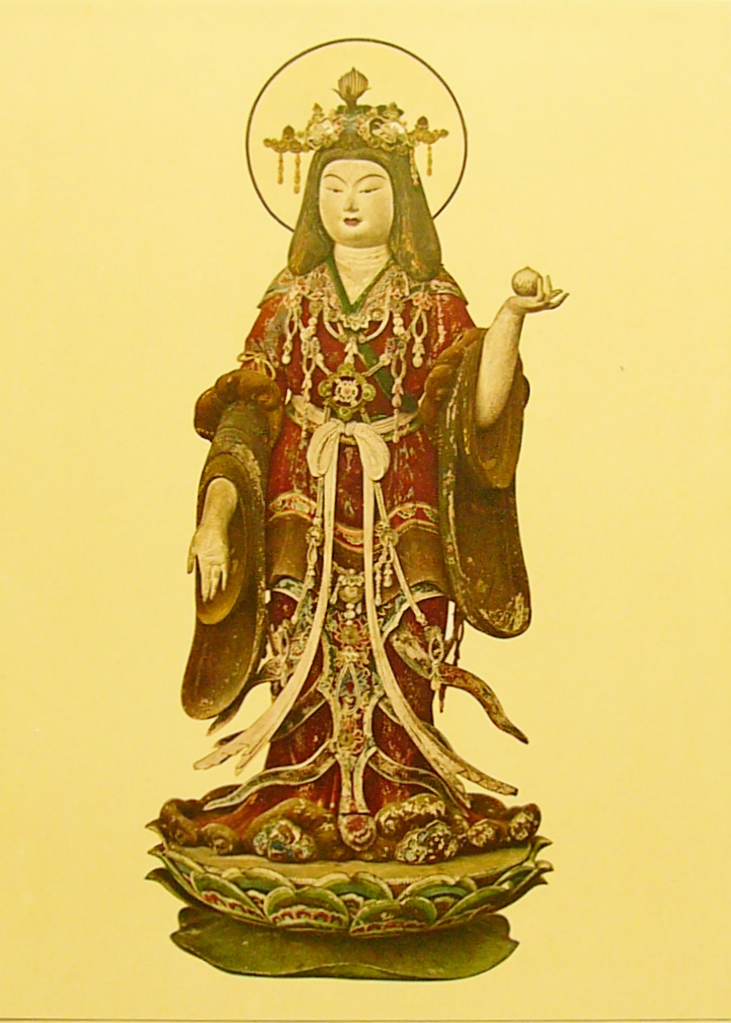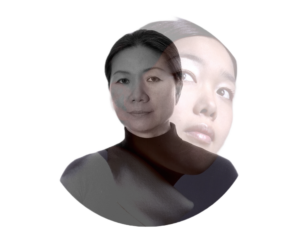
Pure Land
The final photograph in the Esoteric Cosmos series is “Pure Land,” (Fig. 1) the centerpiece of this study. “Pure Land” was created in 1996 and was later turned into a seven-minute 3D video installation called Nirvana, shown at the 47th Venice Biennale in 1997.[78] Standing 10-by-20 feet in a glass-encased photomontage, “Pure Land” depicts Mori front and center as a godlike figure.[79] Pure Land refers to a particular state of rebirth in the Buddhist cycle of reincarnation that ends in Nirvana.[80] Pure Land Buddhism is still a very culturally relevant tradition in Japan, and many artists, like Mori, still create these visual representations and find them important. The Pure Land tradition continues in the Japanese artistic and cultural scenes, particularly in providing basic elements for the aesthetics that are fundamental to the visual arts and their production. Pure Land Buddhism has played a major role in the construction of theories of art and provided motifs for artistic works.[81] There are quite a few Pure Land images. Pure Land style or, jodo, is based on the Buddhist tradition that uses three Mahayana sutras, or the Three Pure Land Sutras. The object of devotion in these texts is Amida Buddha, who preaches a “promise of salvation for all sentient beings” and outlines Amida Buddha’s vows and path to Buddhahood.[82] The Pure Land is the paradise achieved by following the teachings of Amida Buddha. A famous depiction of Pure Land Buddhism can be found in the Hōōdō, or Phoenix Hall at the Byodoin monastery in Uji, south of Kyoto (Fig. 19). Mori’s work is dependent on this exact motif. In this work, Amida Buddha sits on a lotus flower accompanied by bodhisattvas in the clouds. These are the Unchū kuyō bosatsu, or apsaras, that the manga-like musicians are modeled on (Fig. 20).


Unlike the other photographs in the Esoteric Cosmos,” Pure Land is idyllic and more playful than the other three. There is no fire or dark cavern-like underworld. Pinks, oranges, and yellows create a tranquil space that appears decorative or charming, but it goes beyond cute and kitschy, serving as the final step, or float, to Nirvana.[83] In this image, the artist is surrounded by a group of alien-looking musicians on clouds playing traditional Japanese instruments that are still used in Japan today for Shinto and Buddhist ceremonies (Fig. 21).[84] These figures are celestial dancers, singers, and musicians who performed for the gods, similar to the apsaras and Gandharvas in Buddhism and Hinduism. Specifically, the Gandharvas were musicians, and the deva-Gandharva resided in the skies or water with their wives, the apsaras (Fig. 22).[85] Although these figures in “Pure Land” may roughly represent this Buddhist tradition, Mori’s version of the Gandharvas is a very abstract representation of the traditional Gandharva, featuring cartoon-like eyes and animated bodies in a very manga style.[86] The backdrop of this piece is the Dead Sea, with salt formations visible on the surface of the water. In Japanese culture, salt is a symbol of purification. The Dead Sea is the lowest part of the earth, but also the purest in this case.[87] A plantlike or floral “glass palace” sits in the back right of the image, recalling the shape of Tibetan stupas (Fig. 23). A lotus flower floats just below Mori, on the surface of the water.[88] This refers to the belief in Buddhism that one is reborn out of a lotus into paradise (Fig. 24).[89]



In this image, Mori is dressed as Kichijoten, the Japanese female deity of the abundance of many things, such as fertility, fortune, luck, beauty, and merit. Kichijoten is a Buddhist figure present from the Heian Period to the Kamakura Period, as seen in this image from around 1212 at the Jyoruri Temple in Kyoto, Japan (Fig. 25). In her left hand, she holds hoju, a common attribute of Kichijoten. Shaped like the bud of a lotus, it serves a purpose like that of a crystal ball, making wishes come true. Her other hand makes a gesture, forming the Gyan mudra, which we saw in “Burning Desire” from one of the figures surrounding Mori. Normally, Kichijoten forms the mudra of segan-in, which indicates Buddhist charity or the granting of desires.[90] The robe Mori wears, with long, wide sleeves, is like the traditional outfit of Kichijoten, with flowing scarves that protrude from around her sides and create a whimsical sort of movement.[91] Throughout her Esoteric Cosmos, “Pure Land” is the only one that directly references a particular Buddhist deity, perhaps because it is the end of the series. “Pure Land” represents the end of the road, the reaching of Nirvana, the finale.


Kichijoten is also important to the feminist aspects of Mori’s work. Her choice of this character in place of the Amida Buddha, who would normally be present in a Pure Land Buddhism image, does not go unnoticed. This could be translated by feminists as a strike back at the patriarchal Buddhist traditions. However, Mori describes it as more of a yearning to present the visual female beauty. To Mori, bodhisattvas deserve the same kind of attention as any other beautiful figure in our world, past or present day. This duality of cyborg and goddess that I mentioned previously is important to Mori. However, in Pure Land, with Mori cosplaying a Buddhist deity, it seems that this is her destination. Her own identity, the identity of a well-known Buddhist deity, and a technological, digital spin on both, fuse together to reach Enlightenment. The soft and strong visual beauty of Mori’s Nirvana is her as a floating goddess. This is certainly indicative of her own personal journey toward spiritual enlightenment and her emphasis on the connected consciousness and liberation from the chain of life.[92]
